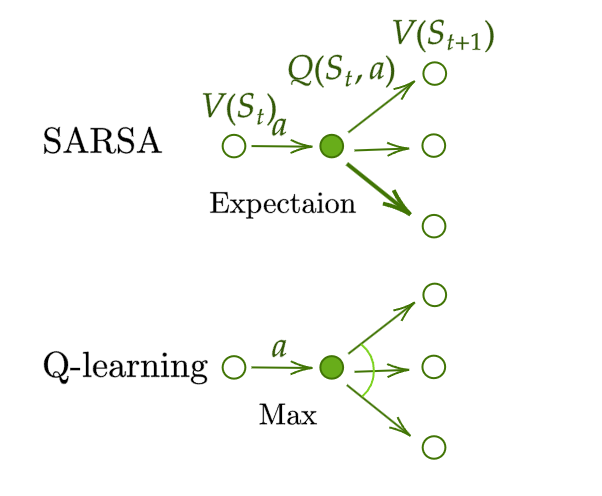
A (Long) Peek into Reinforcement Learning: Part3
RL A (Long) Peek into Reinforcement Learning: Part3
[A (Long) Peek into Reinforcement Learning Lil’Log](https://lilianweng.github.io/posts/2018-02-19-rl-overview/)
Common Approaches
Temporal-Difference Learning (TD)
- model-free
- learns from episodes of experience (incomplete episodes)
Bootstrapping
- bootstrapping: existing estimate $\rightarrow$ update targets
- x need actual rewards and complete returns like MC
Value Estimation
TD method: update $V(S_T)$ to estimated return (TD target ) $G_T = R_{t+1}+\gamma V(S_{t+1})$ \(V(S_t)\leftarrow (1-\alpha)V(S_t)+\alpha G_t \\ V(S_t)\leftarrow V(S_t)+\alpha(R_{t+1}+\gamma V(S_{t+1})-V(S_t))\)
action-value estimation
TD learning (TD control)
SARSA: On-Policy TD control
- Update $Q$ following GPI
$t=0$
$S_0$ choose $A_0=\arg\max_{a\in\mathcal{A}}Q(S_0, a)$, common use $\epsilon$-greedy
At $t$, applying $A_t$, get $R_{t+1}$ and come to next state $S_{t+1}$
Similar to 2. $A_{t+1} = \arg\max_{a\in \mathcal{A}}Q({\color[rgb]{0.29,0.56,0.89}S_{t+1}}, a)$
Update $Q$-value:
$Q ( S_{t}, A_{t} ) \gets Q ( S_{t}, A_{t} )+\alpha( R_{t+1}+\gamma {\color{green}Q ( S_{t+1}, A_{t+1} )} -Q ( S_{t}, A_{t} ) )$
$t=t+1$, to 3.
Q-Learning: Off-policy TD control
$t=0, S_0$
At $t$, choose $A_t=\arg\max_{a\in\mathcal{A}}Q({\color[rgb]{0.29,0.56,0.89}S_t}, a)$, common use $\epsilon$-greedy
At $t$, applying $A_t$, get $R_{t+1}$ and come to next state $S_{t+1}$
Update $Q$-value:
$Q ( S_{t}, A_{t} ) \gets Q ( S_{t}, A_{t} )+\alpha( R_{t+1}+\gamma {\color{green}\max_{a\in\mathcal{A}}Q ( S_{t+1}, a )} -Q ( S_{t}, A_{t} ) )$
$t=t+1$, to 3.
Compared to SARSA, Q-learning do not follow current policy $A_t$ to pick the second action $A_{t+1}$. It estimate $Q^\star \cancel{\leftarrow} Q(\cdot, a^\star)$. $a^\star$ not matter, and in the nest step Q-learning may not follow $a^\star$.

Deep Q-Network
Theoretically, we can memories $Q^*$ for all state-action pairs in Q-learning. However, as state-action pairs become larger and larger, it quickly become computational infeasible. As a result, people use functions (ML models) to approximate $Q$, which is called function approximation, like $Q(s, a,;\theta)$, with parameter $\theta$.
- But as Q-value function approximation combined with bootstrapping, it becomes instability and divergence.
Deep Q-Network(DQN) aims to improve stability of Q-learning, by two innovative mechanisms:
- Experience Replay: All episode steps $e_t=(S_t, A_t, R_t, S_{t+1})$ are stored in one replay memory $D_t={e_1, …,e_t}$. During Q-learning update, drawn random samples from $D_t$, so one sample may be used multiple times. In this way,
- improves data efficiency,
- removes correlations in the observation sequences, and
- smooths changes in the data distribution.
- Periodically Update Target: Q network periodically update the target value in each $C$ steps (C is a hyperparameter). This modification makes the training more stable, as it reduce the short -term fluctuation.
The loss function: \({\mathcal{L}} ( \theta)=\mathbb{E}_{( s, a, r, s^{\prime} ) \sim U ( D )} {\Big[} {\big(} r+\gamma\operatorname* {max}_{a^{\prime}} Q ( s^{\prime}, a^{\prime} ; \theta^{-} )-Q ( s, a ; \theta) {\big)}^{2} {\Big]}\) where $U(D)$ is a uniform distribution over the replay memory $D_t$; $\theta^-$ is the frozen target Q-network.
In addition, clip the error term between $[-1, 1]$ is helpful.

There are many extensions of DQ, like dueling architecture, which estimate state-value function $V(s)$ and advantage function $A(s, a)$ with shared network parameters.
Combining TD and MC Learning
In previous TD learning, we only trace one step on action chain, \(V(S_t)\leftarrow V(S_t)+\alpha({\color{green}G_t}-V(S_t))\) so we can easily extend it to take multiple steps:
Label the estimated return after $n$ steps: $G_t^{(n)}$ \(\begin{align*} n = 1 \quad & G_t^{(1)} = R_{t+1} + \gamma V(S_{t+1}) \quad & \text{(TD learning)} \\ n = 2 \quad & G_t^{(2)} = R_{t+1} + \gamma R_{t+2} + \gamma^2 V(S_{t+2}) \\ \dots \\ n = n \quad & G_t^{(n)} = R_{t+1} + \gamma R_{t+2} + \cdots + \gamma^{n-1} R_{t+n} + \gamma^n V(S_{t+n}) \\ \dots \\ n = \infty \quad & G_t^{(\infty)} = R_{t+1} + \gamma R_{t+2} + \cdots + \gamma^{T-t-1} R_T + \gamma^{T-t} V(S_T) \quad & \text{(MC estimation)} \end{align*}\) The generalized $n$-step TD learning has the same form for update: \(V(S_t)\leftarrow V(S_t)+\alpha({\color{green}G_t^{(n)}}-V(S_t))\) 
We are free to learn any $n$ in TD, so which is the best $n$? Or in another words, which $G_t^{(n)}$ can give the best return approximation. A smart solution is using weight sum of all steps TD target, with the weight decay $\lambda^{n-1}$. This is similar to why we want to discount future rewards:
The longer future we see, the less possibility it takes.
To make all weights sum to $1$, we multiply by $(1-\lambda)$, because: \(\begin{aligned} \text{let } S & =1+\lambda+\lambda^2+\ldots \\ S & =1+\lambda\left(1+\lambda+\lambda^2+\ldots\right) \\ S & =1+\lambda S \\ \text{thus }S & =1 /(1-\lambda) \end{aligned}\) This weighted sum of $n$-step is called $\lambda$-return: \(G_t^{\lambda} = (1-\lambda)\sum_{n=1}^{\infty} \lambda^{n-1} G_t^{(n)}\) TD learning with $\lambda$ is called TD($\lambda$), as the original version is TD($0$).

Comparison of the diagrams of Monte-Carlo, Temporal-Difference learning, and Dynamic Programming for state value functions. \(\begin{align} \text{MC: } & V(S_t)\gets V(S_t)+\alpha (G_t - V(S_t))\\ \text{TD: } & V(S_t)\gets V(S_t)+\alpha (R_{t+1} +\gamma V(S_{t+1})- V(S_t))\\ \text{DP: } & V (S_{t}) \gets \mathbb{E}_{\pi} \left[ R_{t+1}+\gamma V (S_{t+1}) \right] \\ \end{align}\)